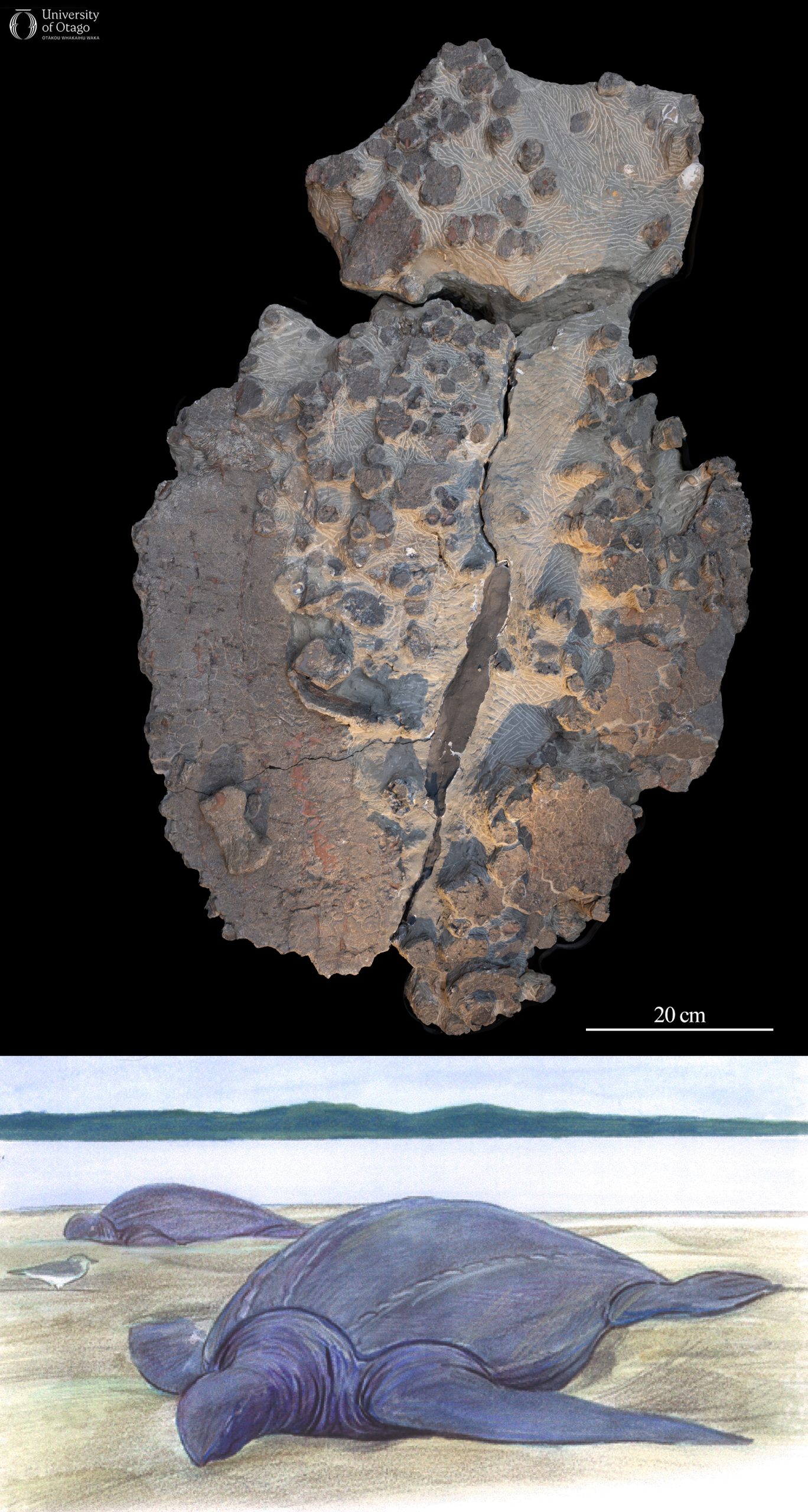13 Fossil from the Discworld? Giant turtle named for famed author
Sauropsida, Testudines: Psephophorus terrypratchetti
Turtles have lived in the seas surrounding Zealandia since at least the Late Cretaceous when the continent was beginning to drift away from the larger southern landmass Gondwana. Although not common in the fossil record, a string of discoveries from each epoch up until the Pliocene show that turtles have been part of the marine fauna of Zealandia for almost the entire history of the now mostly-submerged continent. Cooling global temperatures began to restrict sea turtle distributions towards the tropics following the Pliocene. Today sea turtles are only rare visitors to the northern-most parts of Aotearoa New Zealand although their fossil remains can be found all across the country. A terrestrial freshwater turtle, a possible meiolaniid, is recorded from fragments of a pelvis and a vertebrae in the St Bathans fauna.

Bones from the giant marine turtle Psephophorus terrypratchetti (specimen OU 22177). This fossil is currently on display at Tūhura Otago Museum in the Southern Land, Southern People gallery. Image credit: K Fleury (photograph), C Gaskin (reconstruction). |
New Zealand marine turtle fossils have mostly been found as isolated ossicles, or fragments thereof. Ossicles are bones that make up the carapace and plastron of turtles. These ossicles can be 1 cm or more thick, have a spongy structure in cross section, and can feature an ornamented surface. Fossil turtle bones other than platelets are relatively rare discoveries in Aotearoa, and the discovery of hundreds of bones resting alongside one another as they would have been in life has only been reported once.
 |
Did you know there is a 3D printable model of this fossil for you to view online and download? Follow this link to learn more: 3D model—Fossil from the Discworld? Giant turtle named for famed author. |
In the 1990s a near-complete specimen of the ancient sea turtle Psephophorus terrypratchetti was discovered near Waimate in South Canterbury. This fossil was found in a loose block of Waihao Greensand, a grey to dark-green silty fine sandstone that indicates a quiet marine environment far offshore. This fossil preserves ribs, vertebrae and several hundred ossicles making up the turtle shell. This ancient sea turtle lived during the Eocene, around 40 million years ago, and would have been several metres long in life, slightly smaller than the largest known leatherback turtles.
|
Author Sir Terry Pratchett was thrilled to have a fossil turtle named after him and visited the Otago University Geology Museum to see the specimen. Two images show Richard Köhler describing the turtle to Terry Pratchett. Image copyright: Max and Antonia Köhler. Permission to use this copyrighted work must be obtained from the owner or someone they have authorised. |
In the Discworld Series of novels and associated media for which Sir Terence (Terry) Pratchett was famous, the eponymous world is a disc that is supported on the backs of four elephants who stand astride a giant turtle. The concept of a World Turtle appears in the mythologies of several indigenous peoples and was adopted by the novelist for the Discworld setting where the World Turtle is named Great A’Tuin. In 1995, Otago PhD student Richard Köhler described and named the Waihao Greensand fossil turtle Psephophorus terrypratchetti “…[i]n honour of the British novelist Terry Pratchett, whose wonderful style and great sense of humour, combined with his deep affection for turtles, merits the naming of this new species after him...” Terry Pratchett who saw the fossil on a visit to Dunedin on 23 June 1994 (he gave a talk at the University Bookshop on this visit) is reported to have been proud of the name, writing “Of course I’m proud of it. It tickles my imagination. Forty million years ago this thing was paddling around the globe, eating jellyfish, and now there’s this link to this short bald guy whose own species, at that time, was still saying ‘ook’”
Psephophorus terrypratchetti is described as having “a body armour made up by numerous smooth ossicles which did not show any sculpturing.” This University of Otago fossil is currently on loan to Tūhura Otago Museum in Ōtepoti Dunedin where it can be viewed in the Southern Land, Southern People Gallery.
—Written by Daniel B Thomas
| Specimen number: OU 22177 | Age: Approximately 40 million years old (middle Eocene, Bortonian stage) |
| Locality: Waihao Downs, Canterbury | Rock Formation: Waihao Greensand |
| Collected by: RE Fordyce, A Grebneff, CM Jones | |
| Citation: Köhler R. 1995. A new species of the fossil turtle Psephophorus (Order Testudines) from the Eocene of the South Island, New Zealand. Journal of the Royal Society of New Zealand 25:371–384. doi:10.1080/03014223.1995.9517495 | |
The mostly submerged continent of which New Zealand and New Caledonia are a part.
100.5 to 66 million years ago. The final epoch of the Cretaceous Period.
An ancient landmass that existed from the late Precambrian to the Jurassic, which upon fragmenting gave rise to Africa, Antarctica, Australia, India, Madagascar, South America, and Zealandia.
A unit of geological time that is smaller than a period and larger than a stage. An epoch usually spans several million years.
5.33 to 2.58 million years ago.
An extinct family of large turtles that were probably terrestrial herbivores. Known from South America and Australasia.
Shell on the upper (i.e. dorsal) surface.
Shell on the lower (i.e. ventral) surface.
Massive, glauconitic, dark grey to green silty fine sandstone.
A hydrated iron-rich silicate mineral made up of potassium, iron, aluminum, magnesium, silicon, and oxygen. Generally appears green and is most often found in marine sediments.
A sedimentary rock that is mostly made up of fine sand (0.02 - 0.20 mm diameter grains) but which also includes an appreciable amount of silt (0.002 to 0.063 mm diameter grains).
56 to 33.9 million years ago.
See: Tūhura Otago Museum, Southern Land, Southern People.


